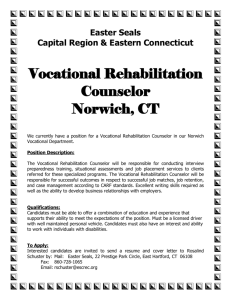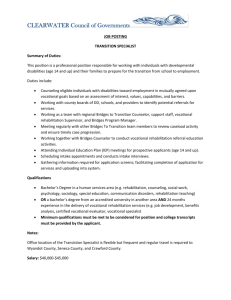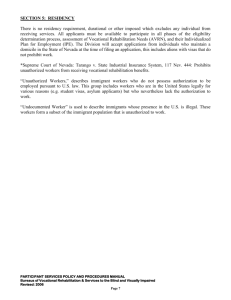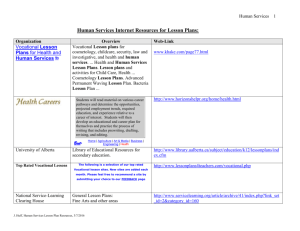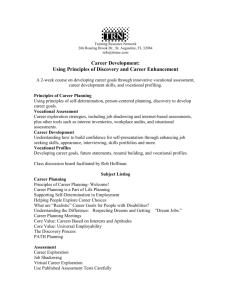Theories and Practices of Vocational Evaluation in Rehabilitation
advertisement
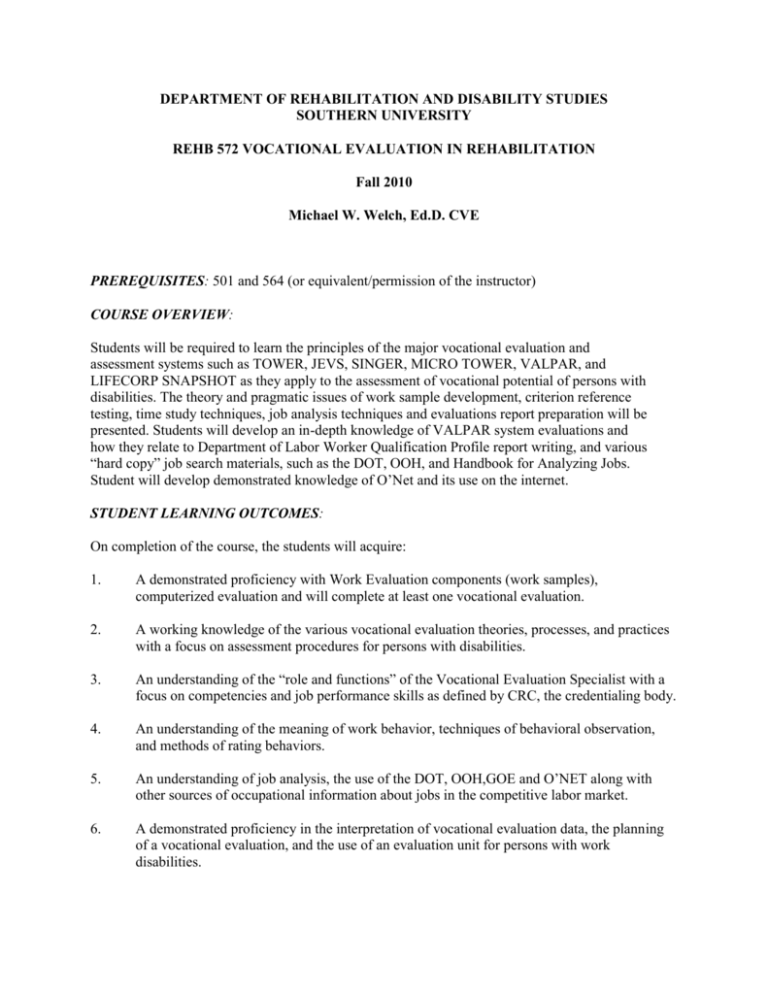
DEPARTMENT OF REHABILITATION AND DISABILITY STUDIES SOUTHERN UNIVERSITY REHB 572 VOCATIONAL EVALUATION IN REHABILITATION Fall 2010 Michael W. Welch, Ed.D. CVE PREREQUISITES: 501 and 564 (or equivalent/permission of the instructor) COURSE OVERVIEW: Students will be required to learn the principles of the major vocational evaluation and assessment systems such as TOWER, JEVS, SINGER, MICRO TOWER, VALPAR, and LIFECORP SNAPSHOT as they apply to the assessment of vocational potential of persons with disabilities. The theory and pragmatic issues of work sample development, criterion reference testing, time study techniques, job analysis techniques and evaluations report preparation will be presented. Students will develop an in-depth knowledge of VALPAR system evaluations and how they relate to Department of Labor Worker Qualification Profile report writing, and various “hard copy” job search materials, such as the DOT, OOH, and Handbook for Analyzing Jobs. Student will develop demonstrated knowledge of O’Net and its use on the internet. STUDENT LEARNING OUTCOMES: On completion of the course, the students will acquire: 1. A demonstrated proficiency with Work Evaluation components (work samples), computerized evaluation and will complete at least one vocational evaluation. 2. A working knowledge of the various vocational evaluation theories, processes, and practices with a focus on assessment procedures for persons with disabilities. 3. An understanding of the “role and functions” of the Vocational Evaluation Specialist with a focus on competencies and job performance skills as defined by CRC, the credentialing body. 4. An understanding of the meaning of work behavior, techniques of behavioral observation, and methods of rating behaviors. 5. An understanding of job analysis, the use of the DOT, OOH,GOE and O’NET along with other sources of occupational information about jobs in the competitive labor market. 6. A demonstrated proficiency in the interpretation of vocational evaluation data, the planning of a vocational evaluation, and the use of an evaluation unit for persons with work disabilities. 7. A working knowledge of various computerized approaches in vocational assessment and evaluation and the use of such commercially prepared data in the evaluation report. TEXTS and Classic References: current references available from reading list. Pruitt, W. (1986). Vocational Evaluation (2nd Ed.). Materials Development Center, University of Wisconsin-Stout, Menominee, WI. Wright, G. (1980). Total Rehabilitation. Boston: Little, Brown & Company. U. S. Department of Labor. (1972). Handbook for Analyzing Jobs. Washington, D. C.: U. S. Government Printing Office. Stanford, E., & Roessler, R. (1995). Foundation of the Vocational Rehabilitation Process. Austin, TX: ProED.. Siefker, J. M. (1992). Vocational Evaluation in the Private Sector, Materials Development Center, University of Wisconsin-Stout. Menomonee, WI. U. S. Department of Labor. (1977). Dictionary of Occupational Titles. Washington, D. C.: U. S. Government Printing Office. Bolton, B. F. (2001). Handbook of Measurement and Evaluation in Rehabilitation (3rd Ed.). Gaithersburg, MD: Aspen. COURSE REQUIREMENTS: Laboratory evaluation and experiences are a critical part of the course. Students will be required to access the internet O’Net site for information concerning vocational evaluation. Students will complete 6 commercial work samples, for 10% each or 30% of the final grade. Students will be required to abstract 10 articles on vocational evaluation (10%). Attendance will make up 10% of the course. The last 50% of the course grade will be made up of mid-semester and final examinations. COURSE REQUIREMENTS: Laboratory evaluation and experiences are a critical part of the course. Students will be required to complete job analyses and access the internet O’Net site for information concerning vocational evaluation. Students will complete 8 commercial work samples, for 30% of the final grade. Students will be required to abstract 10 articles on vocational evaluation (10%). Attendance will make up 10% of the course. The last 50% of the course grade will be made up of mid-semester and final examinations. GRADING CRITERIA: The students will be graded on total points with top total being A and natural break between letter grades. Explained in detail first class meeting. Grades A is the highest score obtained. Grade B is reached when a significant spread between A grades and the next highest score. INSTRUCTOR: Michael W. Welch, Ed. D., CVE Office: 303 (VEWA Lab) Blanks Hall Southern: 771-2667 Mobile: 614-0407 Home: 275-5590 E-mail: mikewelch01@cox.net OFFICE HOURS: 1 p.m. to 2 p.m. Monday-Thursday CLASSROOM: Room 303 Blanks Hall ADMINISTRATIVE REQUIREMENTS Students are expected to attend all class sessions, take all examinations, participate in all class activities, and complete all class assignments. All assignments must be submitted no later than a given date set by the instructor. ACCOMMODATIONS FOR STUDENTS WITH DISABILITIES The Office of Students with Disabilities located in Room 239 Blanks Hall. Please contact Ms. Patricia Hebert, Director for accommodation needs; Phone: 771-3950; Fax: 771-2959; and email: patricia_hebert@subr.edu. LiveText Subscription Southern University and A&M College-Baton Rouge has entered into partnership with LiveText, Inc. to provide online academic resources for student collaboration and learning outcomes assessment. Therefore, all students enrolled in this course are required to purchase a subscription from LiveText, Inc. through the Southern University Bookstore. LiveText, Inc. provides students with the electronic tools and services needed to serve them in their courses and in their career or academic pursuits beyond graduation. LiveText is a dynamic tool that will enable you to: • Create Electronic Portfolios for storing and displaying coursework for use anytime and anyplace; • Share your résumés, professional portfolios and virtually any projects that can be photographed, video recorded, and uploaded to prospective employers and others who need or want to know about your accomplishments; • Engage in discussion boards with other students, exchange feedback, and create study groups and other types of social networks. LECTURES: Week: 1. Introduction to Vocational Evaluation 2. Development of Strategies for Work Sampling, Screening and Testing 3. Job Analysis and Task Analysis (Method Time Measurement) 4. Various Commercial Approaches to Vocational Tasks/Job Analyses 5. Worker Qualification Profile 6. VALPAR, LifeCorp Product Network, Career Assessment 7. Prescreening/Work History i.e., Transferable Skills 8. Vocational Evaluation Planning Mid-Semester Examination 9. Vocational Evaluation I - Screening Devices 10. Vocational Evaluation II - Work Samples 11. Vocational Evaluation Ill - Industrial Testing - Employment Services 12. U. S. Department of Labor Database Analysis/O’Net and DOT. 13. Collective Profile Analysis 14. Job Analysis and Local Job Banks 15. Future Trends: O’Net RESOURCES: 1. Complete Valpar Component Work Sample Lab. 2. Student access to internet through networked computers. 3. Student access to commercial computerized evaluation and databases Final Examination as per the university schedule




